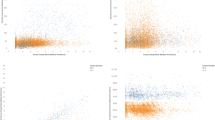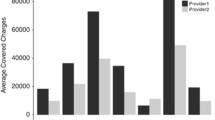Abstract
Historically, Medicare has operated under the assumption that providers respond to reductions in reimbursement through increased provision of services in an effort to offset declining practice revenue; however, some recent empirical work examining fee reductions has found evidence of either small offsetting effects or reductions in the quantity supplied. Using a distance matching approach that matches practices to nearby practices that are subject to different reimbursement rates, we find overall evidence in support of Medicare’s offsetting assumption collectively for all services and for evaluation and management services. We also find evidence consistent with a traditional volume response for imaging and testing services.



Similar content being viewed by others
Notes
The yearly conversion factors for 2000 and 2011 were 36.6137 and 33.9764, respectively. The yearly average MEI, a commonly used measure of inflation in medical practices, for each respective year was 0.80775 and 1.1055, implying a real decline of 32% in compensation per relative value unit across this time period.
Computed using values reported by Board of Trustees, 2015, Table V.D1.
The CPR system effectively compensated for services based on contemporaneous local and historic physician billing patterns.
Examining counties affected and and unaffected by the policy change, we find that 56% of counties experienced a subsequent change in their GAF relative to the 1996 changes that was in a distinct direction from the initial policy change and 48% of these areas experienced a change that was larger in magnitude and in the opposite direction of the sign from the one time payment area consolidation.
As described in the identification methods, the geographic adjustment of costs creates systematic imperfections in the fee schedule causing high cost areas to be under-compensated relative to estimated area costs and low cost areas to be systematically overcompensated. This may cause the construction of their study’s Medicare price measure to be negatively correlated with true Medicare payment generosity implying results consistent with the offsetting hypothesis.
We define “imperfections” in this context as the presence of bias in the adjustment of Medicare fees to a local physician’s costs.
While CMS also adjusts RVUs across time, these changes are relatively minor and do not result in substantial variation in overall reimbursement.
Professional occupations include: (1) architects and engineers, (2) computer, mathematical, life and physical science occupations, (3) social science, community and social service, and legal occupations, (4) education, training, and library occupations, (5) registered nurses, (6) pharmacists, and (7) art, design, entertainment, sports, and media occupations.
These occupations include (1) registered nurses, (2) office and administrative support staff, (3) licensed practical and licensed vocational nurses, and (4) health care technical and medical assistants, and other health care workers.
Some providers, such as anesthesiologists, are compensated under the Part B fee schedule using a distinct payment formula different from the rest of the fee schedule.
Addresses within the data are not always reported in a consistent format. For example, some physicians may report their practice’s explicit address while others report their firm’s name. While using latitude and longitude to generate practices of physicians has the potential to overestimate the individual physician practice size, it produces results comparable to estimation using unique address strings to estimate the size of the practice and alternatively with samples that limit number of physicians, including an analysis of only solo practitioners who would not be subject to this degree of overestimation.
These include: family practice, general practice, geriatric medicine, internal medicine, and pediatric medicine specialties.
Strong financial incentives towards profit maximization are present even among employees and salaried physicians. For example, Rama (2018)’s analysis of compensation sources for non-solo practitioners indicates that approximately 50 percent of employees and independent contractors report some personal productivity as part of their compensation method, and another 12–19% report that practice financial performance factors into their compensation. Further, even salaries are based on performance with 33.8% of employed physicians reporting that their prior year productivity (in terms of RVU production) factors into their base salary determination.
We also note that our results are robust to the consideration of individual physicans. See solo practitioner results in Appendix Table 40.
Geocoding was performed for each address with google maps, Bing, and Geocod.io geocoding services.
It should be noted that our results are robust to the elimination of this restriction as well as the application of much more restrictive county cost criteria (i.e. restricting matches to those with estimated county costs within 0.5–4% of each other Appendix Tables 25, 26 and 27 and imposing no restrictions on county cost criteria Appendix Tables 28, 29 and 30.)
Matching variable descriptions are provided in Table 3.
Duplicate matches are removed by generating a random number followed by a sorting deletion. Evaluating the results across multiple iterations of random deletion of duplicate reciprocal matches, we find results of comparable magnitude and significance to primary reported results. Further, robustness tests under alternative sampling methods such as isolating to only one FIPS code, produce results that support the primary analysis.
For procedures with modifiers, we construct reimbursement using the observed physician GPCIs and the yearly conversion factor and examining and classifying the appropriate RVUs for the physician as the RVUs that are closest to the physician’s average reimbursement for the procedure. While this may create some magnitude of measurement error depending on the physician’s mixed use of modifiers, these procedures do not represent a substantial proportion of claims.
This restriction eliminates non-reimbursable procedures such as some modifiers and blood work tests that must be bundled with a visit and are reimbursed through a separate CPT code.
Though we note that our results are robust to the inclusion or exclusion of controls or state-pair fixed effects.
Year fixed effects may be important to control for unobserved inter-temporal changes and alterations in the yearly conversion factor.
This sets the sum of weights for the practice equal to unity.
For that matter, the authors are unaware of any studies that comprehensively evaluate physician responses to reimbursement changes controlling for the entire menu of procedures and patient types, implying that no existing studies have completely controlled for income effects of reimbursement changes.
As a robustness test, we also evaluated whether the GAF Ratio had heterogeneous effects based on whether the the observation was compensated above or below the matched practice. These alternative models, produced coefficients of identical sign to those reported in the primary analysis and F-tests of equality revealed little to no evidence of heterogeneous responses.
Calculation based on the largest observed GAF Ratio observed in Table 2, GAF Ratio=1.153.
Given the small sample size, we did not estimate results for the other BETOS categories.
We also evaluated results restricting matches to those within the same Metropolitan Statistical Area and found results that directly support the primary analysis.
For example, Lasser et al. (2008) estimated that family practice physicians in 2004 receive approximately 15% of their revenue from Medicare vs. 35% for Cardiologist, and 60% for Nephrologists.
Examining Medicare Part B Physician/Supplier Data by BETOS CY2015 for the allowed charges by BETOS category, we observe $85,951,372,836 allowed charges with $46,215,079,894, $6,885,597,072, $12,447,128,949, $9,625,803,280, and $10,777,763,641 annual charges for E&M, non-elective procedures, elective procedures, imaging services, and testing services, respectively. As a result E&M, non-elective procedures, elective procedures, imaging services, and testing services represent 53.7%, 8%, 14.5%, 11.2%, and 12.5% of annual allowed charges.
References
Brunt, C. S. (2015). Medicare Part B intensity and volume offset. Health Economics, 24(8).
Christensen, S. (1992). Volume responses to exogenous changes in Medicare’s payment policies. Health Services Research, 27(1), 65–79.
Clemens, J., & Gottlieb, J. D. (2014). Do physicians’ financial incentives affect medical treatment and patient health? The American Economic Review, 104(4), 1320.
Cubanski, J., Damico, A., Neuman, T., & Jacobson, G. (2018). Sources of supplemental coverage among medicare beneficiaries in 2016
Edmunds, M., Sloan, F. A., et al. (2012). Geographic adjustment in medicare payment: Phase I: Improving accuracy. Washington: National Academies Press.
Government Accountability Office. (2007). Medicare geographic areas used to adjust physician payments for variation in practice costs should be revised. GAO-07-466. Technical report.
Hadley, J., & Reschovsky, J. D. (2006). Medicare fees and physicians’ Medicare service volume: Beneficiaries treated and services per beneficiary. International Journal of Health Care Finance and Economics, 6(2), 131–50.
Hadley, J., Reschovsky, J., Corey, C., & Zuckerman, S. (2009). Medicare fees and the volume of physicians’ services. Inquiry, 46(4), 372–90.
Kaestner, R., Garrett, B., Chen, J., Gangopadhyaya, A., & Fleming, C. (2017). Effects of ACA Medicaid expansions on health insurance coverage and labor supply. Journal of Policy Analysis and Management, 36(3), 608–642.
Lasser, K. E., Woolhandler, S., & Himmelstein, D. U. (2008). Sources of us physician income: The contribution of government payments to the specialist-generalist income gap. Journal of General Internal Medicine, 23(9), 1477–1481.
McGuire, T. G., & Pauly, M. V. (1991). Physician response to fee changes with multiple payers. Journal of Health Economics, 10(4), 385–410.
Medicare Board of Trustees. Review of assumptions and methods of the Medicare trustees’ financial projections, Dec 2012. Retrieved April 20, 2019, from https://aspe.hhs.gov/system/files/pdf/180601/TechnicalPanelReport2010-2011.pdf
MEDPAC. Health Care Spending and the Medicare Program, June 2015.
Mitchell, J. B., & Cromwell, J. (1995). Impact of Medicare payment reductions on access to surgical services. Health Services Research, 30(5), 637–55.
Mitchell, J. M., Hadley, J., & Gaskin, D. J. (2000). Physicians’ responses to Medicare fee schedule reductions. Medical Care, 38(10), 1029–39.
Mitchell, J. M., Hadley, J., & Gaskin, D. J. (2002). Spillover effects of Medicare fee reductions: Evidence from ophthalmology. International Journal of Health Care Finance and Economics, 2(3), 171–88.
Nguyen, N. X., & Derrick, F. W. (1997). Physician behavioral response to a Medicare price reduction. Health Services Research, 32(3), 283–98.
Rama, A. (2018). Policy research perspectives how are physicians paid? a detailed look at the methods used to compensate physicians in different practice types and specialties. American Medical Assocation: Technical report.
Rice, T. H., & McCall, N. (1982). Changes in Medicare reimbursement in Colorado: Impact on physicians’ economic behavior. Health Care Financing Review, 3(4), 67–85.
Rice, T. H. (1983). The impact of changing Medicare reimbursement rates on physician-induced demand. Medical Care, 21(8), 803–15.
The Boards Of Trustees, Federal Hospital Insurance And Federal Supplementary Medical Insurance Trust Funds. (2015) Annual Report Of The Boards Of Trustees Of The Federal Hospital Insurance And Federal Supplementary Medical Insurance Trust Funds, July 2015.
Volume-and-Intensity Response Team, Office of the Actuary. (1998). Physician volume and intensity response, 8 1998. Retrieved April 20, 2019, from https://www.cms.gov/Research-Statistics-Data-and-Systems/Research/ActuarialStudies/downloads/PhysicianResponse.pdf
Yip, W. C. (1998). Physician response to Medicare fee reductions: Changes in the volume of coronary artery bypass graft (cabg) surgeries in the medicare and private sectors. Journal of Health Economics, 17(6), 675–99.
Zuckerman, S., Norton, S. A., & Verrilli, D. (1998). Price controls and Medicare spending: assessing the volume offset assumption. Medical Care Research and Review, 55(4):457–78; discussion 479–83.
Author information
Authors and Affiliations
Corresponding author
Additional information
Publisher's Note
Springer Nature remains neutral with regard to jurisdictional claims in published maps and institutional affiliations.
Appendices
Appendix 1: Histograms of dependent variables and full results
See Figs. 4, 5, 6, 7 and 8, Tables 7, 8, 9, 10, 11, 12, 13, 14, 15, 16, 17, 18, 19, 20, 21, 22, 23 and 24.
Appendix 2: Results with alternative restrictions on practice matching GAF* input costs
See Tables 25, 26, 27, 28, 29 and 30.
Appendix 3: Results with alternative distance restrictions on practice matching
See Tables 31, 32, 33, 34, 35, 36, 37, 38 and 39.
Appendix 4: Further robustness tests
Rights and permissions
About this article
Cite this article
Brunt, C.S., Hendrickson, J.R. Geographic variation in Part B reimbursement and physician offsetting behavior: a physician matching approach. Int J Health Econ Manag. 21, 115–188 (2021). https://doi.org/10.1007/s10754-021-09297-3
Received:
Accepted:
Published:
Issue Date:
DOI: https://doi.org/10.1007/s10754-021-09297-3









